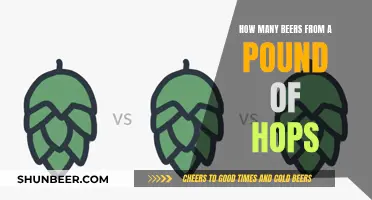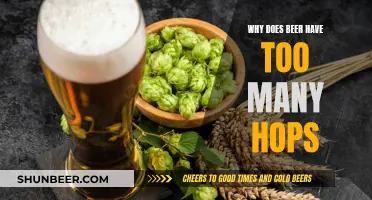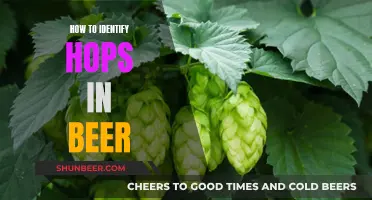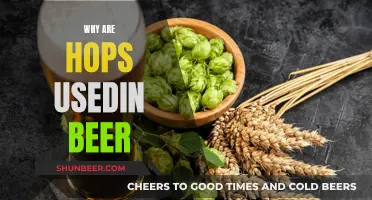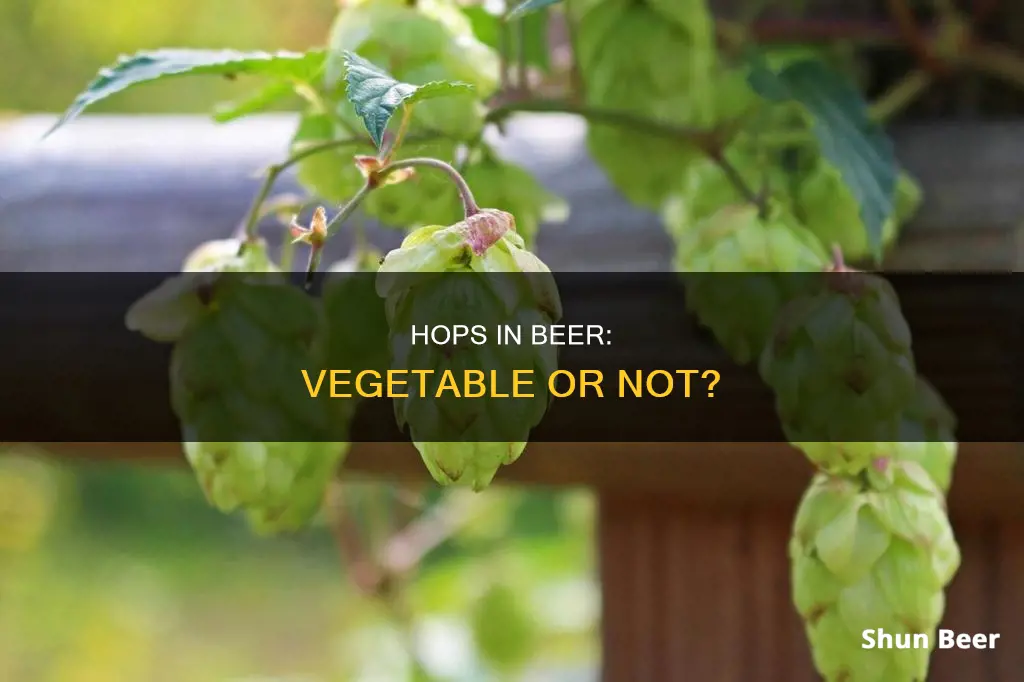
Hops are the flowers of the hop plant, Humulus lupulus, and are one of the basic ingredients used in brewing beer. They are often referred to as a vegetal ingredient due to their plant origin, but are they technically a vegetable? Hops are not typically consumed directly as a vegetable, but rather processed and used in brewing to impart bitterness, aroma, and preservative qualities to beer. While they possess certain characteristics of vegetables, such as their plant origin and nutritional content, their primary use as a flavouring agent in beer sets them apart from traditional vegetables.
| Characteristics | Values |
|---|---|
| Botanical Name | Humulus lupulus |
| Plant Type | Climbing, herbaceous perennial |
| Plant Family | Cannabaceae |
| Plant Parts Used | Flowers, cones |
| Flower Colour | Green-yellow |
| Flower Taste | Bitter |
| Flower Aroma | Floral, fruity, citrus |
| Plant Cultivation Method | Grown on trellises of string or wire |
| Plant Producers | Washington, Oregon, Idaho, Maine, Germany, Poland, Czech Republic, New Zealand |
| Flower Harvest Time | End of summer |
| Flower Preservation Method | Dried |
| Flower Use | Beer brewing, herbal teas, infusions, salads, stir-fries |
| Other Plant Parts Used | Young shoots |
What You'll Learn
- Hops are the flowers of the hop plant, Humulus lupulus
- Hops are used as a bittering, flavouring, and stability agent in beer
- They are cultivated for their flowers, which contain lupulin glands that impart bitterness and aroma to beer
- Hops are not typically consumed directly as a vegetable, but they are the most expensive vegetable in the world
- Hops are primarily valued for their flavouring properties in beer

Hops are the flowers of the hop plant, Humulus lupulus
Hops are the flowers of the hop plant, *Humulus lupulus*. This species is a perennial, herbaceous climbing plant that can grow up to 10 metres (33 feet) tall and has a lifespan of up to 20 years. It is native to West Asia, Europe, and North America, and is cultivated worldwide for its flowers, which are used in beer brewing.
The hop plant is dioecious, meaning it has separate male and female plants. The female plants produce cone-shaped flowers (hops) that are used for brewing. These flowers contain tiny glands that produce chemicals such as humulones, which are important for brewing. The hop flowers are harvested at the end of summer and then dried before use.
Hops are valued in brewing for the bitter and aromatic qualities they impart to beer. They contain an essential oil with a bitter flavour that balances the sweetness of the malt and acts as a preservative. The ratio of sweet maltiness to bitterness in beer can be adjusted by brewers by changing the type of hops used, when they are added, and how long they are boiled.
The hop plant is a member of the hemp family, Cannabaceae, and it has a complex genetic structure that is still being studied. The specific epithet "lupulus" means "small wolf" in Latin, referring to the plant's tendency to strangle other plants.
Hops' Role in Brewing: Aromatic and Bitter Beer Balancing
You may want to see also

Hops are used as a bittering, flavouring, and stability agent in beer
Hops are the flowers of the hop plant, Humulus lupulus, a member of the Cannabaceae family of flowering plants. They are primarily used as a bittering, flavouring, and stability agent in beer. Hops add bitterness and impart floral, fruity, or citrus flavours and aromas to beer. They also have antibacterial properties, which help prevent spoilage and contribute to the stability of the beer.
The hop plant is a climbing, herbaceous perennial that is usually trained to grow up strings in a field called a hopfield or hop yard. The plants have separate female and male flowers, and only the female plants are used for commercial hop production. The cones of the female plants are harvested at the end of the summer and then dried in an oast house to reduce their moisture content.
The hops contain an essential oil with a very bitter flavour, which counters the sweetness of the malt in beer. This bitterness is provided by alpha acids or humulones, which are isomerized into iso-alpha acids or isohumulones during the brewing process. These isohumulones are responsible for the bitter taste of beer.
In addition to bitterness, hops also contribute to the flavour and aroma of beer. This is influenced by the type of hops used, when they are added to the wort, and how long they are boiled. Aroma hops, for example, are typically added later in the process to preserve their aromatic essential oils.
Hops also play a role in stabilising beer foam and have antibacterial properties, which help prevent spoilage and contribute to the overall stability of the beer.
Hops' Preservative Powers: Keeping Beer Fresh
You may want to see also

They are cultivated for their flowers, which contain lupulin glands that impart bitterness and aroma to beer
Hops are the flowers of the hop plant, *Humulus lupulus*, a member of the Cannabaceae family of flowering plants. They are cultivated for their flowers, which are used primarily as a bittering, flavouring, and stability agent in beer. The hop plant is a climbing, herbaceous perennial, usually trained to grow up strings in a field.
The hop plant has separate female and male plants, and only female plants are used for commercial production. The female flowers, or cones, are known as hops and are harvested at the end of summer before being dried. These hops contain lupulin glands that produce a yellowish, waxy substance called lupulin, which imparts flavour and aroma to beer. Lupulin is composed of lupulone and humulone, which have antibiotic properties that suppress bacterial growth, allowing brewer's yeast to grow.
The content of alpha bitter acids, such as humulones, in hop cones can differentiate aromatic from bitter hop cultivars. The higher the accumulation of alpha bitter acids in the lupulin glands, the more bitter the hops. The density of lupulin glands on the hop cones also influences the bitterness of the hops.
The hop plant is unique in that it contains secondary metabolites, flavonoids, oils, and polyphenols that impact the flavour of the products they are used in, such as beer. The bitter flavours in hops can be attributed to acids composed of prenylated polyketides, a group of secondary metabolites that highly influence the taste of hop-based products.
Grow Your Own Hops for Beer: A Step-by-Step Guide
You may want to see also

Hops are not typically consumed directly as a vegetable, but they are the most expensive vegetable in the world
Hops are the flowers of the hop plant, Humulus lupulus, a member of the Cannabaceae family of flowering plants. They are a basic ingredient in beer brewing, providing the bitterness and aroma that is often loved in beer. Hops are also used in herbal teas, soft drinks, and herbal medicine. While hops are technically a vegetable, they are not typically consumed directly as such. Instead, they are used to flavour other products, like beer.
Hops are expensive, with prices ranging from $2.50 per ounce to over $5 for coveted varieties. They are one of the most expensive ingredients when brewing beer, commonly taking up over fifty per cent of a hop-heavy recipe's budget. The high price of hops can be attributed to several factors. Firstly, starting a hopyard is costly, with significant capital required for infrastructure, equipment, and labour. Hopyards also take several years to become profitable, and ongoing costs for land and facilities can be substantial. For example, Perrault Farms, Inc. in Washington averaged approximately $5 million per year in capital expenses between 2012 and 2019.
The hops industry is also susceptible to various risks, including pest outbreaks, mildew, and wildfires, which can destroy crops and increase costs for farmers. Additionally, the development of new and exciting hops varieties, which are essential for the industry, can take years and come with no guarantee of success. The high demand for specific hop varieties, particularly for popular craft beers like IPAs, can further drive up prices.
With all these factors considered, it's no wonder that hops are considered the most expensive vegetable in the world, despite not being commonly consumed directly.
The Hoppy Truth: Do All Beers Have Hops?
You may want to see also

Hops are primarily valued for their flavouring properties in beer
Hops are the flowers of the hop plant, Humulus lupulus, a member of the Cannabaceae family of flowering plants. They are used primarily as a bittering, flavouring, and stability agent in beer. Hops add bitterness, aroma, and flavour to beer. The hop plant is a climbing, herbaceous perennial, usually trained to grow up strings in a field called a hopfield, hop garden, or hop yard when grown commercially.
Hops contain an essential oil with a very bitter flavour. This bitterness counters the sweetness from the malt to create a more balanced beer. Beer makers can adjust the type of hops used in the brewing, when they’re added to the wort, and how long they’re boiled to play with the ratio of sweet maltiness to bitterness in the final beer.
There are two main types of hops: bittering and aroma. Bittering hops have higher concentrations of alpha acids, and are responsible for the large majority of the bitter flavour of a beer. European (so-called "noble") hops typically average 5–9% alpha acids by weight (AABW), and the newer American cultivars typically range from 8–19% AABW. Aroma hops usually have a lower concentration of alpha acids (~5%) and are the primary contributors of hop aroma and (non-bitter) flavour.
Aroma hops are typically added to the wort later to prevent the evaporation of the essential oils, to impart "hop taste" (if during the final 30 minutes of boil) or "hop aroma" (if during the final 10 minutes, or less, of boil). Aroma hops are often added after the wort has cooled and while the beer ferments, a technique known as "dry hopping", which contributes to the hop aroma.
Hops also help to keep beer fresher for longer and help beer retain its head of foam—a key component of a beer’s aroma and flavour.
Hops Beer: The Secret Behind the Bitter Buzz
You may want to see also
Frequently asked questions
Hops are the flowers of the hop plant, Humulus lupulus, a member of the Cannabaceae family of flowering plants.
Hops are considered a different type of vegetable. While they are cultivated for their flowers, which are used in brewing, they are not typically consumed directly as a vegetable. They are primarily valued for their flavouring properties in beer.
Hops contain an essential oil with a very bitter flavour. This bitterness counters the sweetness from the malt in beer.
Hops help to keep beer fresh for longer, help beer retain its head of foam, and add aroma and flavour. They also act as a preservative.


